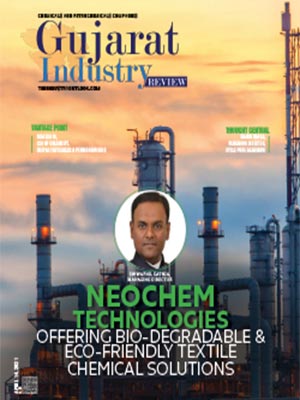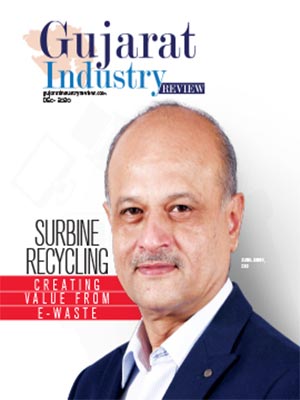Infusing Consistency In Manufacturing
Team Gujarat Industry Review
Excerpts from an interaction with Alok Kirloskar, Head- International Business, Kirloskar Brothers Limited and Managing Director, SPP Pumps Limited, UK
India is on the verge of the Industrial Revolution 4.0. How do you see the adoption of IIoT in the Indian Manufacturing Industry? What are the global best practices and learning we should adopt?
The revolution in IIoT has begun in India and I feel many opportunities lie ahead of us. That said, I think in a country like India there should be a balance in terms of which industry or sectors, or areas need to be automated, considering the high CAPEX involved. For industries that are in precision manufacturing, the cost of automation will be extremely steep owing to the high level of intricacies and sophistication that'll be required for the deployment of robots. On the other hand, some industries might just want to invest in sensors for data analytics and estimating efficiency. These companies would want to invest in upskilling their workers for achieving manufacturing consistency. For heavy manufacturing, the CAPEX on automation will be very high, but it will also lead to consistency. Hence the payback on automation should be an important consideration for deploying it.
Industry 4.0 for India will be about effective data analytics for process adherence and identifying the areas where a high degree of consistency is important. Effective data analysis with a focus on creating skillsets will enable companies to maintain their processes and also get the benefits of India’s demographic dividend. India also needs to focus on creating vocational training systems like say in Germany for creating capabilities for high precision manufacturing and for infusing consistency in manufacturing.
Manufacturing plants and factories have to embrace automation to stay relevant in the long run. AI-driven machines add significant value to the manufacturing process as they enable automation of tasks, enhance production efficiency, and bring machine interaction closer to human interaction. How do you see the adoption of AI in the manufacturing sector?
AI will be adopted in the manufacturing processes from application engineering in their operations to service and support. AI is useful not only because it can help support tasks but also because it enables the preservation of knowledge and information. It also supports the timely extraction of information for implementing in current situations. These benefits of AI will help companies train their new generation of employees and maintain consistency, reduce TAT for service requests and client inquiries, and also help to improve client services.
Please elaborate on how the use of AI and ML can create more job opportunities rather than job loss in the manufacturing sector.
I believe, once AI and ML are integrated into the manufacturing process, it will create new jobs for people rather than job loss. These can range from programming the systems all the way to helping convert working practice to logic so that the machine can appreciate reasons and procedures to complete certain tasks that were done by humans. Also, in case of sudden changes, one will still need humans to optimize and make a decision. For example, in the case of COVID, if the factory load reduces, it is still a call that human beings have to take for stoppage of work or reducing to a three-day week schedule, rather than follow an optimized schedule churned out by a machine. I think still a majority of ‘reference-to context’ roles will remain with humans.
Employers in receiving countries take a different position; they have shortages of skilled people in specific fields and can drain a developing country of expertise by providing job opportunities. Please elaborate on how higher allocation in research and development funds can help in preserving the talent pool and reverse the brain drain in India?
I think most progressive countries will continue to attract the best of brains into their country as these create wealth and along with it, jobs. Our government also needs these to get taxes on a sustainable basis and run a state. It's also the reason that both Russia and China restricted the movement of people overseas since the 1990s. While Russia did have a strong research program, it did not stop people from trying to go to the USA. I think this helps us understand that only research and development funds are not the answer, people want to know they will be able to use and commercialize this technology and whether such opportunities are available in the country of their origin and will be a determining factor on where they choose to live. But to answer the question, I think enhancing R&D funds will help develop new technologies and will keep some of the best brains in the country engaged so that the country can get something back for all the subsidies they provide to universities and research organizations.
Modern technology is the need of the hour in the manufacturing industry’s shift towards digitization and distancing in post-COVID days. How does the adoption of new technologies such as AR/VR, Blockchain, Data Analytics, etc. help in competing with western counterparts?
All these technologies are different and they support a number of activities in different ways. But they will not make a company which is not innovative by nature, suddenly an innovator. Technologies like AR and VR are great for providing field support and training. Although they are not a complete substitute for vocational training. On the other hand, better data analytics and maybe a step before that which is better data collection because of sensors, etc will help businesses understand process adherence issues, monitor efficiencies, and thus make informed decisions. Blockchain on the other hand will provide traceability and accountability on transactions, especially if it's used within a company. I agree that all these technologies will help us work better remotely and will also flatten the organization. I also believe Indian companies would need more than just these technologies to compete with their western counterparts and that would be in effect a cultural change, enhancing focus on the skilled workforce and understanding about optimal automation.
3D Printing provides cost-effectiveness with its focus on lean manufacturing. The defense, aerospace, healthcare and automotive industries have been early adopters of 3D Printing in India. How do you think 3D Printing is going to change the manufacturing industry?
3D printing is a fantastic technology and like all technologies, companies need to evaluate the one that is easy to monetize for the business. I think matching your business to the appropriate technology is the key to getting a good return from it. 3D printing varies from printing metals to plastics to moulds and so it has the ability to make a massive change to industries that are more specialised/bespoke and where there is a lower level of repeatability. However, the printer beds get the larger grouping of specialized items into batches will provide a disruptive advantage on cost.
Which technologies do you think have massive potential for the manufacturing industry but are yet to be implemented in the industry?
I don’t think there is a dearth of technologies available today to enhance our productivity in the manufacturing process. I believe most have been talked about in this interaction. But in times like these, we realise that it's really important to connect with people. The objective of all these technologies is to save time and not hassle humans with repetitive tasks. The objective is to ensure humans stop fire-fighting and have time to think about the next big thing for their organisation. We need to use this time to engage with our people, guide them and help them understand the vision of our companies so they can direct their thoughts and efforts effectively and we can get the best out of them.
Read More
Supply Chain Management Becomes Integrated
Impact Of Covid-19 On Manufacturing Industry And Its After Affects




